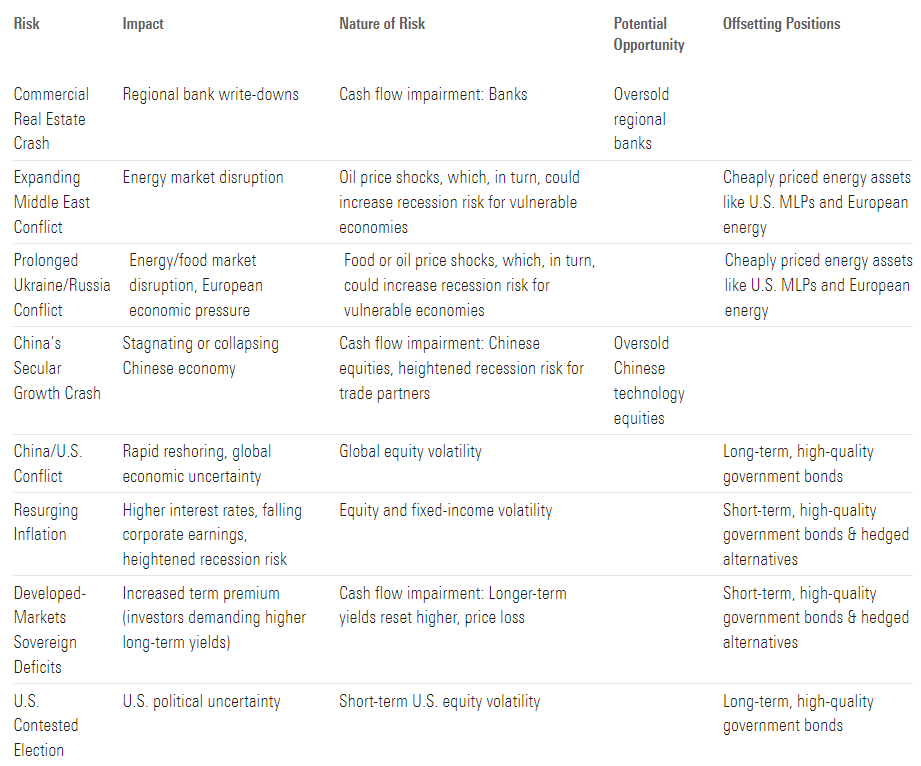
Investors are always walking the tight rope of risk, particularly when risk comes in the form of external shocks. But aiming for accurate predictions around risk is a fool's game.
Rather than predict, we prepare. The perception of risk can greatly affect market sentiment, often creating opportunities, too. We seek to understand both sides of the coin.
The current market conditions highlight several significant challenges for investors. The key at this juncture is accepting the reality of market risks while not becoming unnerved by them. It's easy to lose one's bearings amid the continuous stream of market news and speculation, dubbed as "black swan hunting".
As investors, it is critical to discern this noise from facts, focusing on long-term investment strategies rather than panic-induced decisions sparked by temporary market fluctuations. If anything, lean into the volatility and reframe nervousness as excitement for opportunities.
As we stand near the start of 2024, it's crucial investors harness the power of behavioural science in maneuvering through the risks that lie in the landscape of economy and geopolitics. As a starting point, let;s collectively agree that uncertainty is always present, with at-times terrifying headlines dominating our collective consciousness.
Nevertheless, equities, which make up the lion's share of most investors' portfolios, have managed to return 7.4% per year after inflation over the trailing 100 years (S&P 500 total real return, annualised), allowing investors to compound returns despite two world wars, the Cold War, a global pandemic, and a range of local economic crises. That shift in perspective, from the narrow "what just happened?" to the broader "how do market cycles evolve?" is key in helping imperfect decision-makers choose wisely in the face of irreducible uncertainty.
The Market Hates Uncertainty and Negative Surprises
The resilience of the broader markets may be cold comfort as we look at the litany of known risks facing us at the start of 2024, particularly for those with shorter investment time horizons. The samplings below are top of mind for us.
:quality(80)/cloudfront-us-east-1.images.arcpublishing.com/morningstar/4CSTMQEONREH7A254637HGKNCM.png)
This collection of concerns is daunting, but it's worth remembering not every risk requires a whole new portfolio to survive its realisation. A well-calibrated portfolio – a collection of global equities, fixed income across a range of maturities, and, at least for our part, carefully-selected hedged strategies designed to limit overall interest-rate risk – should weather external shocks fairly well.
In other words, we can build robust portfolios that can hold up to a variety of different eventualities; we don't have to have a crystal ball to know what is going to happen next. Rather, we can build portfolios that find and protect value over a wide range of "what ifs."
In fact, to the extent an external shock causes sudden negative sentiment, we likely would consider the price dislocation an opportunity. That was the case during the coronavirus pandemic, for example. Recall that, in March 2020, global equities crashed in unison, while liquidity concerns froze bond markets, including the US Treasury market, which is known as a global safe haven. As the pandemic developed and lockdowns ensued, we had no greater foresight than anyone else on the range of potential outcomes. What we did know was asset prices were getting crushed far beyond our estimates of normalised fair value.
As a result, our portfolio managers around the globe added risk – equities (for example, energy stocks), high-yield bonds, emerging-markets bonds, and more – as quickly as we could. The rest is history. After a 22% correction between February 20, 2020, and April 7, 2020, global equity markets rallied tremendously. Despite the massive loss, the Morningstar Global Markets Index managed a 16% return for 2020 in its entirety.
What Techniques Help Portfolio Risk?
Not every external shock follows the Covid-19 path. Some really do impair cash flows, meaning the fair value of the asset permanently deteriorates. A recent, extreme example? Russian equities in the wake of the Ukraine invasion.
In other instances, a portfolio may not be as well calibrated as the investor thinks. Perhaps that's because a position wasn't sized correctly given all its risks or the underlying fundamentals of an offsetting position weren't fully understood. The latter has been the case for investors who assumed long-term Treasuries would always perfectly offset the risks of equities. While big returns from stocks have helped recoup much of 2022's losses, it could take fixed-income investors longer to make up for the 6.25% annualised loss over the trailing two-and-a-half years, given the traditionally lower returns in that market.
Of course, none of that matters if it's possible to predict with certainty both the risk and the ensuing market impact. However, we argue essentially impossible. Think about the most momentous events in recent market history: Covid-19 and lockdowns; global inflation; aggressive central bank policy. Few of these developments were predicted accurately, and if a particular investor was able to call one risk, they were unable to predict the rest.
With an appreciation for uncertainty firmly in mind, we believe the best approach to managing external shocks – geopolitical or otherwise – is ongoing fundamental asset-class analysis and careful portfolio construction.
With these two tools firmly in hand, we'll walk through the 2024 risks we've identified. We include the expected impact of these risks, any opportunities that could emerge, and potential offsets we believe could mitigate possible damage.
Our Approach to Handling New Risks as We Enter 2024

Here's the overarching takeaway for external risks in 2024: they exist, as they always do, but we believe the vast majority relate to volatility and present as much opportunity as loss potential. The very essence of external shocks is their uncertainty, both in timing and magnitude.
Without question, many risks potentially have a higher probability than what's on this list, but we just don't know about them yet. It's with this uncertainty in mind that we think having a robustly-constructed portfolio that considers the full range of outcomes is a critical component to investing success.
Valuation Risk is Often Ignored, But Really Matters
Overvaluation risk is a real problem that's never featured on the laundry list of what can go wrong. Everything has a price, with swings in perceived risk creating potential mispricing. No bad news? Likely elevated valuations. A lot of perceived risk? Possibility of attractive prices.
Some great companies have high valuations and need significant growth to deliver on market expectations. In this regard, we believe the very narrow market leadership of large-cap US technology names in 2023 has provided an interesting investing landscape looking ahead to 2024 and beyond. Much of the US market's gains in the first half of 2023 were driven by the extraordinary returns of just a handful of companies. It is not to say that the so-called "Magnificent Seven" are not great companies, but they do have high valuations and need significant growth to deliver on market expectations.
Said simply, some markets have no room for error or disappointment. Other markets are priced for a story of despair – China equities, for equities – where only a little needs to go right. Fundamentals matter, especially with higher rates, so investing where there is a valuation buffer or margin of safety is key for the years ahead. This is a story that we see play out again and again in markets.
Will There be Upside in China?
To be clear, we acknowledge the uncertainty that surrounds these markets, and we have no better clarity than others on how it will play out. To manage those concerns, we rely on scenario testing to determine our positioning. Here's what we ask:
1. How much can we own, assuming the worst happens, without jeopardising our overall portfolio outcomes?
2. Do we have overlapping exposure here that we don't see at first blush? How can we manage these risks?
Valuations are an underrated tool to shift the risk to reward in your favour. And where headline risks are plentiful, we often find tomorrow’s golden opportunities.
New Risks, Consistent Approach
Patience and perspective are key in the world of investing. Before making any move, consider what is already priced in and how the markets have already adjusted. While risk might initially sound intimidating, it isn't always a bad thing. Risk can be a catalyst for opportunity if managed with care. After all, in the world of investments, risk not only creates a possibility of loss but also forges avenues for gain.
Risk and reward are different sides of the same coin, and investors cannot expect outsize gains without taking on some risk. This does not feel intuitive, as our brains are not wired for patience or for eagerly embracing uncertainty. Histrionic headlines don't help. However, discipline and long-term perspective are never out of style and investing principles can pay off most handsomely during turbulent times.
While the risks we face as we enter 2024 are significant, they are not insurmountable. The keys are to stay calm, focus on the long term, sift through the noise, and apply robust risk-management techniques. Remember, even in the face of risk, opportunity lies. Armed with a thorough understanding of the market, sound strategies, and a cool head, investors can not only weather the current market conditions but also find potential opportunities amid them.








:quality(80)/cloudfront-us-east-1.images.arcpublishing.com/morningstar/Q7DQFQYMEZD7HIR6KC5R42XEDI.png)




















